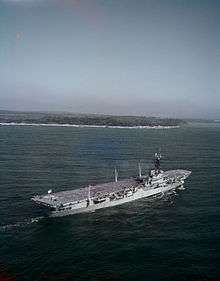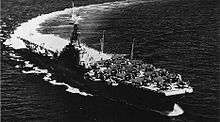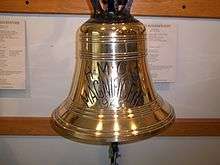HMCS Magnificent (CVL 21)
_underway_c1950.jpeg) HMCS Magnificent circa 1950. | |
| History | |
|---|---|
| Name: | Magnificent |
| Ordered: | 16 October 1942 |
| Builder: | Harland and Wolff, Belfast |
| Yard number: | 1228[1] |
| Laid down: | 29 July 1943 |
| Launched: | 16 November 1944 |
| Fate: | Loaned to Canada, 1948 |
| Name: | Magnificent |
| Acquired: | January 1945 |
| Commissioned: | 21 March 1948 |
| Decommissioned: | 14 June 1957 |
| Struck: | 1961 |
| Homeport: | Halifax, Nova Scotia |
| Identification: | CVL 21 |
| Motto: | "We stand on guard"[2] |
| Nickname(s): | "The Maggie" |
| Honours and awards: |
|
| Fate: | Returned to UK, scrapped in Faslane, July 1965 |
| Badge: | Purpure, a sun in splendour or on which a maple leaf gules[2] |
| General characteristics | |
| Class and type: | Majestic-class aircraft carrier |
| Displacement: | 15,700 long tons (16,000 t; 17,600 short tons) |
| Length: | 698 ft (212.75 m) |
| Beam: | 80 ft (24.38 m) |
| Draught: | 25 ft (7.62 m) |
| Propulsion: | 4 Admiralty 3-drum boilers, 2 shafts, Parsons geared steam turbines, 40,000 shp (30,000 kW) |
| Speed: | 24 knots (44.4 km/h) |
| Complement: | 1100 (including air group) |
| Sensors and processing systems: |
|
| Armament: |
|
| Aircraft carried: | 37 - Fairey Firefly and Hawker Sea Fury |
HMCS Magnificent (CVL 21) was a Majestic-class light aircraft carrier that served the Royal Canadian Navy from 1948–1957. Initially ordered by the Royal Navy during the Second World War, the Royal Canadian Navy acquired the carrier as a larger replacement for its existing carrier. She was generally referred to as the Maggie in Canadian service. Following its return to the United Kingdom in 1956, the ship remained in reserve until being scrapped in 1965.
Construction and design
The 1942 Design Light Fleet carrier was divided into two groups of which the Majestic class was one. The Majestic class was intended to be similar in design to the preceding Colossus class but with reduced storage for petrol and fuel, down to 75,000 gallons. This was to compensate for the strengthening of the deck in order to operate heavier aircraft[3] up to 20,000 pounds (9,100 kg).[4] Further improvements over the Colossus class included larger lifts (54 by 34 feet (16 m × 10 m)) and improvements made to internal subdivisions for survivability purposes and accommodations.[4]

The third ship of the Majestic class, Magnificent was ordered 16 October 1942. The order was placed with Harland and Wolff in Belfast who were also constructing sister ships Glory and Warrior.[1] She was laid down 29 July 1943 and launched on 16 November 1944.
The ship was 698 feet (212.75 m) long with a beam of 80 ft (24.38 m) and a draught of 25 ft (7.62 m).[5] The carrier displaced 15,700 long tons (16,000 t; 17,600 short tons) and had a complement of 1100 (including the air group). Majestic-class carriers were fitted out with Type 281, Type 293 and two Type 277 radar installations.[4]
The ship was powered by four Admiralty 3-drum boilers creating 40,000 shp (30,000 kW). This powered two Parsons geared steam turbines driving two shafts.[3] Magnificent had a top speed of 24 knots (44.4 km/h).[5]
The aircraft carrier was armed with 24 2-pounder and 19 Bofors 40 mm guns for anti-aircraft defense.[3]
Aircraft

Magnificent operated both fixed and rotary-wing aircraft. In preparation for her joining the Royal Canadian Navy, the two squadrons formerly assigned to Warrior, 803 and 825 Squadrons, were designated 19th Air Group and embarked Sea Furies and Firefly IVs respectively. 883 (fighter) and 826 (torpedo bomber/reconnaissance) Squadrons were re-activated and formed the 18th Carrier Air Group. They embarked Seafires and older model Fireflies respectively.[6]
In 1950, the Canadian government purchased 75 Grumman TBF Avengers from the United States Navy for use on Magnificent. They were intended to replace the Fireflies in 825 and 826 Squadrons.[7] In May 1951, the squadrons were renumbered with 18 Air Group becoming 30 Air Group with 883 Squadron becoming 871 Squadron and 826 Squadron becoming 881 Squadron. 19 Air Group became 31 (Support) Air Group with its squadrons being renumbered from 803 and 825 becoming 870 and 880 respectively.[1]
In 1955, the RCN purchased Sikorsky H04S helicopters and equipped them with dunking sonars. The first squadron, HS-50, embarked aboard Magnificent in July 1955.[8] In September 1955, the Canadian navy began using United States Navy-style designations for its air units. VF-871 was composed of Sea Furies and VS-881 comprised Avengers. In February 1956, Maggie embarked a second helicopter unit, HU-21.[1]
Acquisition

In May 1944, the Royal Canadian Navy (RCN) intended to expand its fleet in size of ships with if it were to take on a larger role in the Pacific theatre.[5] In October, the RCN offered to exchange the American-built escort carriers the RCN was currently operating, Puncher and Nabob, with the intention to acquire larger aircraft carriers from the Royal Navy.[9] The six Majestic-class ships were considered surplus to Royal Navy plans, and the three furthest along in construction were offered for loan.[4]
In January 1945 the RCN negotiated the loan of two ships, Warrior (Colossus class) and Magnificent with the option to purchase at a later date.[5] Government approval of the deal was approved in February 1945.[9] Initially acquired from the Royal Navy to be part of Canada's Pacific fleet during the Second World War, Maggie was eventually acquired to replace Warrior, as the latter had been built in a hurry to serve in the Pacific and was unable to operate in cold climates.[6]
Due to delay in her completion, Magnificent was fully capable of operating in cold climates. The carrier was commissioned into the Royal Canadian Navy on 21 March 1948.[5]
Operational history
.jpeg)
Following her arrival in Halifax on 1 June 1948, Magnificent performed workups. During workups she lost two aircraft.[1] She was deployed in September 1948 to the Hudson Strait in one of her first missions.[6] With the destroyers Nootka and Haida, the aircraft carrier sailed on a training cruise to the Ungava peninsula in Quebec, halting at Wakeham Bay, Quebec. From there the two destroyers left the aircraft carrier and toured the north, becoming the first RCN warships to penetrate Hudson Bay.[10] In January 1949, Magnificent sailed to the United Kingdom to embark Firefly Vs that replaced the Firefly IVs of 825 Squadron. Upon the aircraft carrier's return, 825 Squadron was disembarked at Dartmouth, Nova Scotia and 803, 883 and 826 Squadrons embarked for the training cruise to the Caribbean Sea.[11]
1949 'mutiny'
On 20 March 1949, while on fleet manoeuvres in the Caribbean, thirty-two aircraft handlers on Magnificent briefly refused an order to turn to morning cleaning stations to protest various grievances. The captain acted with great sensitivity to defuse the crisis, holding an informal discussion with the disgruntled crew members and carefully using the term "incident" instead of "mutiny", which could have resulted in severe legal consequences for the handlers.[12]
At almost the same time, similar incidents happened on Crescent, at Nanjing, China and on Athabaskan at Manzanillo, Colima, Mexico, both of whose captains acted similarly to that of Magnificent.[13]
Training and visits

Following the incident in the Caribbean, in June 1949, she went aground off Port Mouton, Nova Scotia. With the help of destroyers, Maggie was refloated and taken to Saint John for repairs.[1] With the outbreak of the Korean War, Magnificent was withheld from service in that theatre on the grounds that she was already committed to NATO duties.[14]
Maggie spent most of her time performing port visits and training.[5][15] In December 1951, the carrier began a refit lasting until March 1952.[1] In September 1952, the carrier took part in the large NATO Exercise Mainbrace, and again in 1953 as part of the exercise "Mariner".[5] In 1953 she took part in the Fleet Review to celebrate the Coronation of Queen Elizabeth II.[16] 16 aircraft (8 Sea Furies and 8 Avengers) took part in the fly past. In March 1954, Maggie underwent a refit at Portsmouth.[1] In 1955, Magnificnet sailed to the Caribbean Sea for training exercises with the US and Royal Navies, escorted by Micmac and Haida and then sailed to Portsmouth before returning to Canada.[17] The aircraft carrier, escorted by Micmac, Haida and Huron, made a second cruise to Europe beginning in September, making several port visits and participating in two NATO naval exercises.[18] In 1956, she operated helicopters from her deck for the first time during a naval exercise.[8] That same year, on 10 October, a TBF Avenger made the last fixed-wing flight from the deck of Magnificent.[1]
Suez Crisis
On 6 November 1956, the St. Laurent government chose to join the United Nations Emergency Force, agreeing to send ground forces to Egypt.[19] Maggie was chosen to transport the men and supplies to Egypt, being withdrawn from a training exercise to do so in November.[20] In preparation for use as a transport, the ship's weapons were stripped,[21] and her complement reduced to 600.[1] The initial plan was to embark the Queen's Own Rifles of Canada, however that order was rescinded in December. Magnificent waited in Halifax until the end of the month[20] when she embarked 406 Canadian troops and their vehicles[5] along with 4 Royal Canadian Air Force de Havilland Canada DHC-3 Otters and a single H04S helicopter and sailed for Egypt.[1] She arrived in Port Said in early January 1957. This was to be her last role, carrying a large part of the Canadian peacekeeping force to Egypt, its vehicles parked on her deck.[20] She returned to Canada in March.[1]
Decommissioning

Magnificent left Canada in April 1957 and arrived at Plymouth on 14 June for decommissioning.[5] She was replaced in RCN service by Bonaventure, another Royal Navy Majestic-class carrier (HMS Powerful) that had not been completed at the end of the war. She was returned to the RN in 1957 and placed in reserve until disposed of. Maggie's inability to operate the modern jet aircraft of the time led to her return and replacement.[7] The ship was placed on the disposal list in 1961 and remained there until 1965.[1] The ship was broken up at Faslane, Scotland in July 1965.[5][22]
See also
- List of aircraft carriers
- List of ship launches in 1944
- List of ship commissionings in 1946
- List of ship decommissionings in 1956
- List of ships of the Canadian Navy
References
Citations
- 1 2 3 4 5 6 7 8 9 10 11 12 13 Hobbs, 2013. pp. 205-6
- 1 2 3 Arbuckle, p. 63
- 1 2 3 Chesneau, 1980. p. 22
- 1 2 3 4 Hobbs, 2013. p. 199
- 1 2 3 4 5 6 7 8 9 10 Macpherson and Barrie, 2002. p. 237
- 1 2 3 Milner, 2010. p. 168
- 1 2 Milner 2010, p. 209
- 1 2 Milner 2010. p. 212
- 1 2 Milner, 2010. p. 140
- ↑ "In Hudson's Wake". The Crowsnest. Vol. 1 no. 1. King's Printer. November 1948. pp. 4–5.
- ↑ "New Aircraft". The Crowsnest. Vol. 1 no. 4. King's Printer. February 1949. p. 2.
- ↑ Milner, 2010. p. 192
- ↑ Gimblett, Richard. "Dissension in the Ranks,'Mutinies' in the Royal Canadian Navy". CFB Esquimalt Naval & Military Museum. Archived from the original on 8 October 2006.
- ↑ Tracy 2012, p. 116
- ↑ Milner, 2010. p. 201
- ↑ Souvenir Programme, Coronation Review of the Fleet, Spithead, 15th June 1953, HMSO, Gale and Polden
- ↑ "HMCS Magnificent". The Crowsnest. Vol. 7 no. 7. Queen's Printer. May 1955. p. 17.
- ↑ "Ships Sail For Mediterranean". The Crowsnest. Vol. 8 no. 1. Queen's Printer. November 1955. p. 2.
- ↑ Carroll 2010, p. 122
- 1 2 3 Carroll 2010, pp. 122-3
- ↑ Tracy, 2012. p. 127
- ↑ "World Aircraft Carriers List: Canada". Hazegrey.org. Retrieved 3 August 2015.
References
- Arbuckle, J. Graeme (1987). Badges of the Canadian Navy. Halifax, Nova Scotia: Nimbus Publishing. ISBN 0-920852-49-1.
- Carroll, Michael K. (2010). Pearson's Peacekeepers: Canada and the United Nations Emergency Force, 1956-67. UBC Press. ISBN 9780774858861.
- Chesneau, Roger, ed. (1980). Conway's All the World's Fighting Ships 1922–1946. Greenwich, UK: Conway Maritime Press. ISBN 0-85177-146-7.
- Hobbs, David (2013). British Aircraft Carriers: Design, Development & Service Histories. Barnsley, UK: Seaforth Publishing. ISBN 978-1-84832-138-0.
- Macpherson, Ken; Barrie, Ron (2002). The Ships of Canada's Naval Forces 1910-2002 (3rd ed.). St Catharines, Ontario: Vanwell Publishing. ISBN 1-55125-072-1.
- Milner, Marc (2010). Canada's Navy: the First Century (2nd ed.). Toronto: University of Toronto Press. ISBN 978-0-8020-9604-3.
- Tracy, Nicolas (2012). A Two-Edged Sword: The Navy as an Instrument of Canadian Foreign Policy. McGill-Queen's University Press. ISBN 0773540512.
External links
| Wikimedia Commons has media related to HMCS Magnificent (CVL 21). |
| Wikimedia Commons has media related to Aircraft carriers of Canada. |
- The Canadian Navy of Yesterday & Today Photo Gallery: HMCS Magnificent
- HMCS Magnificent Light Fleet Carrier
- My experience aboard the HMCS Magnificent by Lieutenant Robert Grenier